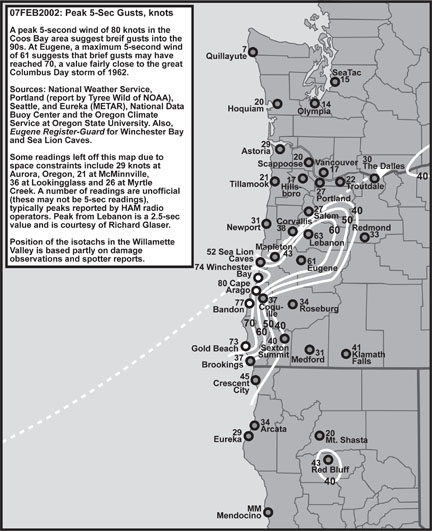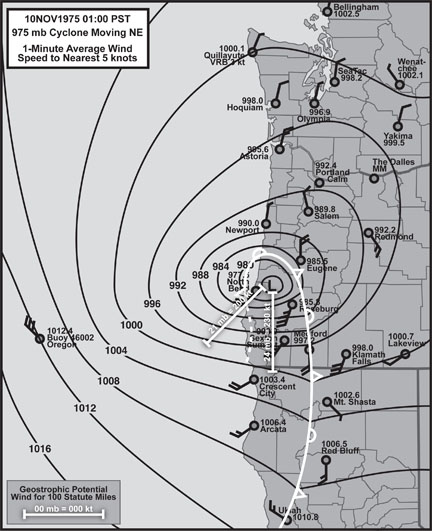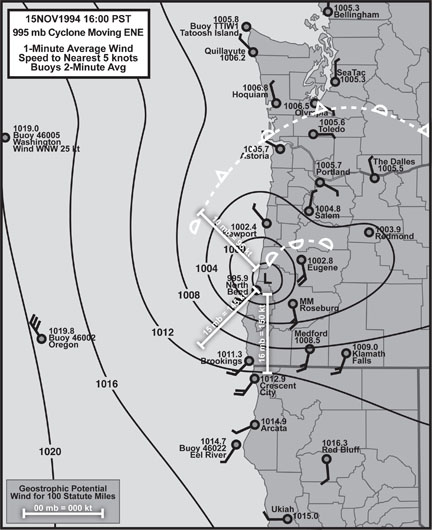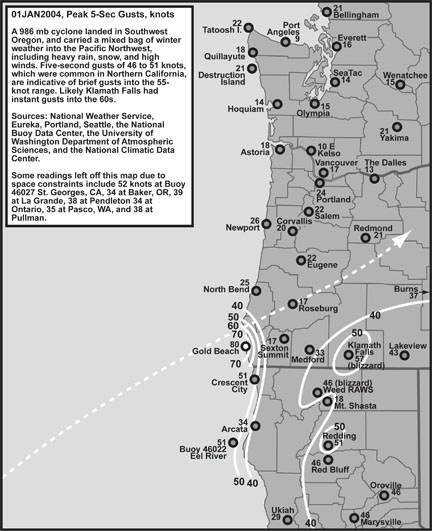|
07 Feb 2002
 
07 Feb 2002: This 994 mb windstorm developed rapidly inside 130º W, and therefore was generally missed by the offshore buoy network. High winds with this storm were particularly violent over a very narrow stretch of land. Peak short-distance gradients included +9.0 mb RBG-EUG and +6.0 mb EUG-CVO. Unlike other storms in this class, positive gradients behind the storm exceeded the maximum negative gradients ahead of the low for stations north of the track. The reversal from strong negative to strong positive was sudden, especially in Oregon, happening within the space of two hours. The sharp reversal negative to positive is likely a reflection of a strong northeasterly track. For comparison to other events, peak negative gradients included -7.1 mb OTH-AST, -2.2 mb AST-UIL, -5.4 mb EUG-PDX, -2.6 mb PDX-SEA and -3.9 mb SEA-BLI.
A particularly well-developed bent-back occlusion appears to have enhanced the pressure gradient in a small region near the core of the 07 Feb 2002 storm; the cyclone’s strongest winds followed the tip of this front, generally sweeping a swath about 25 to 50 statute miles wide. See Steenburg and Mass [1] for a detailed analysis of the dynamics of bent-back fronts in a Pacific Northwest storm. At Cape Arago, 2-minute average winds reached 65 knots, with a 5-second gust to 81, the expected results for a Category-I hurricane! At North Bend, a 1-hour pressure surge of +14.2 mb also had the flavor of a hurricane. In the Willamette Valley, pressure tendencies matched those of the infamous Columbus Day storm of 1962. The ASOS station at Eugene measured a peak 2-minute wind of 52 knots with a 5-second gust to 61 at the height of the storm, readings that are likely second only to the Columbus Day storm for the 1948-2004 period. The geostrophic potential for the pressure gradient over 100 statute miles on the south side of the storm reached about 150 knots, and on the southwest side of the storm 125 knots. The latter supports the measured winds at Cape Arago quite nicely.
The morning after the 07 Feb 2002 storm struck the South Willamette Valley, the author toured the region by car. Of interest was strong indication of narrow lines of extreme wind that caused extensive damage, with areas to either side relatively unharmed. There appeared to be a “background” wind of about 30 knots with gusts to 45 in most places affected by the storm, with wind velocities apparently escalating to 50-60 knots with gusts in the range of 60-70, perhaps higher, in the narrow bands of very high wind. Some of these lines continued for long distances across the valley. One such band seemed to extend from the Eugene Mahlon Sweet Field to Junction City and then beyond. Woodlots impacted by the high-wind bands suffered heavy tree damage, with as much as 25% of trees being broken or uprooted. Lines of power poles were broken in places, in some cases for lengths of a kilometer. Near the junction of I-5 and state highway 228, a steel power pole buckled under the force of the gale.
|







